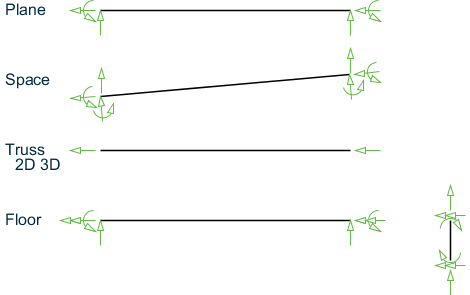TR.2 Problem Initiation and Model Title
This command initiates the STAAD run and is also used to specify the type of the structure and provide an optional title.
General Format
STAAD { PLANE | SPACE | TRUSS | FLOOR } (any_title )
Where:
- any_title = Any title for the problem. This title will appear on the top of every output page. To include additional information in the page header, use a comment line containing the pertinent information as the second line of input.
Notes
-
Care must be taken about choosing the type of the structure. The choice is dependent on the various degrees of freedom that need to be considered in the analysis. The following figure illustrates the degrees of freedoms considered in the various type specifications. Detailed discussions are available in G.2 Types of Structures. PLANE indicates the XY plane for Y up and the XZ plane for Z up. FLOOR indicates the XZ floor for Y up and the XY floor for Z up.
-
The optional title provided by you are printed on top of every page of the output. You can use this facility to customize his output.
Limits
The following limits to model size are effective for STAAD.Pro CONNECT Edition V22 Update 2 (release 22.02.00) and later.
- Number of joints: 400,000*
- Joint number 1 to 999,999
- Number of Members, Physical Members, Plates, and Solids: 500,000*
- Member/Element numbers: 1 to 999,999
- Number of primary and combination cases: 10,101
- Load Case numbers: 1 to 99,999
- Number of modes and frequencies: 2,700
- Number of load cases that may be combined by a Repeat Load or Load Combination command: 550
* Some STAAD.Pro copies are available with much smaller limits, please check what limits you have purchased.
Notes: The numerical limits should be considered as upper limits built into the software for those quantities on an individual basis. In practice, the actual maximums the program can handle are determined by the hardware resources as well as the limits imposed by the operating system. For example, it is highly improbable that a single model with 500,000 members and 10,101 load cases can be solved.
The memory demand of the program is determined by the combined effect of two or more of these terms. For example, when a steel design is performed, the memory required depends on the product of the members being designed (NMD) as well as the number of load cases being designed for (NL). That is, NMD ×NL. So the smaller the NMD, the larger the NL capacity and vice versa.

